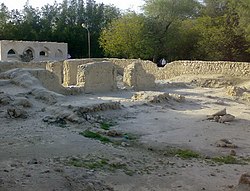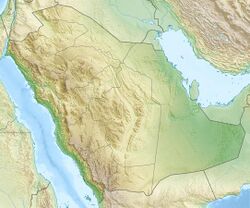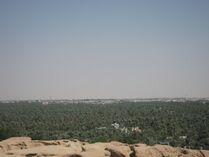Place:Al-Hasa
| UNESCO World Heritage Site | |
|---|---|
 Jawatha Mosque in Al-Ahsa | |
| Location | Hofuf, Al-Ahsa Governorate, Saudi Arabia |
| Criteria | Cultural: (iii), (iv), (v) |
| Reference | 1563 |
| Inscription | 2018 (42nd session) |
| Area | 8,544 ha |
| Buffer zone | 21,556 ha |
| Coordinates | [ ⚑ ] : 25°25′46″N 49°37′19″E / 25.42944°N 49.62194°E |
Al-Ahsa, Al-Hasa, or Hadjar (Arabic: الأحساء al-Aḥsāʾ, locally al-Ahasā) is a traditional oasis historical region in eastern Saudi Arabia whose name is used by the Al-Ahsa Governorate, which makes up much of that country's Eastern Province. The oasis is located about 60 km inland from the coast of the Persian Gulf.
Al-Ahsa is part of the region known historically for its high skill in tailoring, especially in making bisht, a traditional men's cloak.[1] Al-Bahrain geographical province is in Eastern Arabia, which includes the eastern coast of the Arabian Peninsula down to the borders of the UAE, Oman, and also includes the island of Awal (modern-day Bahrain). Historically, Al-Ahsa was the main city in Al-Bahrain province, making up most of its population and providing most of its agricultural output.
The site has become a World Heritage site in 2018.[2] It has also been part of UNESCO Creative Cities Network since December 2015.[3]
Etymology
Al-Ahsa is a plural word of "Al-Hisa" (Arabic: الحِسَى) which refers to the accumulated sand with solid underneath. Thus, if the rain comes down, the sand would prevent the sun from drying the water up, and the solid base would stop it from submerging. Hence, the site would become when drilled like a sweet cold spring.[4]
History
Al-Ahsa has been inhabited since prehistoric times, due to its abundance of water in an otherwise arid region.[5] Natural fresh-water springs have surfaced at oases in the region for millennia, encouraging human habitation and agricultural efforts (date palm cultivation especially) since prehistoric times. Recently, Al-Ahsa Oasis has been nominated as one of the seven wonders of the world.[citation needed]
Its early history is similar to that of Eastern Arabia. In 899 A.D., the region came under the control of the Qarmatian leader, Abu Tahir al-Jannabi,[6] and was declared independent from the Abbasid Caliphate of Baghdad. Its capital was at al-Mu'miniya near modern Hofuf. By circa 1000, Al-Hasa became the 9th largest city worldwide supporting 100,000 inhabitants.[7] In 1077, the Qarmatian state of Al-Ahsa was overthrown by the Uyunids. Al-Ahsa subsequently fell under the rule of the Bahrani dynasty of the Usfurids, followed by their relatives, the Jabrids, who became one of the most formidable powers in the region, retaking the islands of Bahrain from the princes of Hormuz. The last Jabrid ruler of Bahrain was Muqrin ibn Zamil.
In 1521, the Portuguese Empire conquered the Awal Islands (the islands that comprise present day Bahrain) from the Jabrid ruler Muqrin ibn Zamil, who fell strongly in battle.[8] The Jabrids struggled to maintain their position on the mainland in the face of the Ottomans and their tribal allies, the Muntafiq. In 1550, Al-Ahsa and nearby Qatif came under the sovereignty of the Ottoman Empire with Sultan Suleiman I.[9] Al-Ahsa was nominally the Eyalet of Lahsa in the Ottoman administrative system, and was usually a vassal of the Porte. Qatif was later lost to the Portuguese.[citation needed]
The Ottomans were expelled from Al-Ahsa in 1670,[9] and the region came under the rule of the chiefs of Banu Khalid tribe.
Al-Ahsa, along with Qatif, was incorporated into the Wahhabist Emirate of Diriyah in 1795, but returned to Ottoman control in 1818 with an invasion ordered by Muhammad Ali of Egypt. The Banu Khalid were again installed as rulers of the region but, in 1830, the Emirate of Nejd retook the region.
Direct Ottoman rule was restored in 1871,[9] and Al-Ahsa was placed first under Baghdad Vilayet and with Baghdad's subdivision Basra Vilayet in 1875. In 1913, ibn Saud, the founder of modern Saudi Arabia, annexed Al-Ahsa and Qatif into his domain of Najd.[10]
On December 2, 1922, Percy Cox officially notified Kuwait's Emir Sheikh Ahmad Al-Sabah that Kuwait's borders had been modified.[11] Earlier that year, Major John More, the British representative in Kuwait, had met with Ibn Saud of Saudi Arabia to settle the border issue between Kuwait and Najd. The result of the meeting was the Uqair Protocol of 1922, in which Britain recognized ibn Saud's sovereignty over territories claimed by the emir of Kuwait.
Economy
Historically, Al-Hasa was one of the few areas in Arabian Peninsula growing rice.[12]
In 1938, petroleum deposits were discovered near Dammam,[13][14] resulting in the rapid modernization of the region. By the early 1960s, production levels reached 1 million barrels (160,000 m3) per day. Today, Al-Hasa engulfs the largest conventional oil field in the world, the Ghawar Field.
Al-Hasa is famous for its palm trees and dates. Al-Hasa has over 30 million palm trees which produce over 100 thousand tons of dates every year.
Touristic sites
- Springs
The number of springs and freshwater sources in Al-Hasa oasis range from 60 to 70 like those in Ummsaba'ah, Al-Harrah and Al-Khadod.
- Antiquities
Al-Hasa oasis filled with a number of archaeological sites that give witness to the area's importance.
- Landmarks
12 locations were defined as the Cultural Landscape of Al-Hasa Oasis (the World Heritage site).[2]
- Eastern Oasis (الواحة الشرقية)
- Northern Oasis (الواحة الشمالية)
- As-Seef (السِيف)
- Suq Al-Qaysariyah (سوق القيصرية)
- Qasr Khuzam (قصر خزام)
- Qasr Sahood (قصر صاهود)
- Qasr Ibrahim (قصر ابراهيم)
- Jawatha archaeological site (موقع جواثا الأثري)
- Jawatha Mosque (مسجد جواثا)
- Al-'Oyun village (قرية العيون)
- 'Ain Qinas archaeological site (موقع عين قيناس الأثري)
- Al-Asfar lake (بحيرة الأصفر)
Climate
Script error: No such module "weather box".
Notes
- ↑ al Mukhtar, Rima (9 November 2012). "Traditional & modern: The Saudi man's bisht". http://www.arabnews.com/fashion/traditional-modern-saudi-mans-bisht.
- ↑ 2.0 2.1 "Al-Ahsa Oasis, an evolving Cultural Landscape". UNESCO. http://whc.unesco.org/en/list/1563/multiple=1&unique_number=2228.
- ↑ "Al-Ahsa enters UNESCO Creative Cities Network" (in en). Arab News. 2015-12-13. http://www.arabnews.com/saudi-arabia/news/849681.
- ↑ "تعريف و معنى الاحساء في معجم المعاني الجامع - معجم عربي عربي" (in Arabic). almaany.com. https://www.almaany.com/ar/dict/ar-ar/%D8%A7%D9%84%D8%A7%D8%AD%D8%B3%D8%A7%D8%A1/.
- ↑ http://www.hcci.org.sa/English/AlAhsa/Pages/AboutAlahsa.aspx
- ↑ Wheatley, Paul (2001). The Places Where Men Pray Together: Cities in Islamic Lands, Seventh Through the Tenth Centuries. University of Chicago Press. p. 129. ISBN 978-0-226-89428-7. https://books.google.com/books?id=h0ANg137kEMC&pg=PA129.
- ↑ Al Hasa population soared to 100,000 by circa 1000
- ↑ Al-Juhany, Uwidah Metaireek (2002). Najd before the Salafi reform movement: social, political and religious conditions during the three centuries preceding the rise of the Saudi state. London: Ithaca Press. p. 53. ISBN 0-86372-401-9. https://books.google.com/books?id=MzN1Mo8_bd4C&pg=PA53&dq=1521+Awal+portegese&lr=&as_brr=3&ei=nMlnSPGOMJSCjwHw6rX-BQ&sig=ACfU3U3mjovC2GTKf3AYcJyVVudqoib4dA.
- ↑ 9.0 9.1 9.2 Long, David (2005). Culture and Customs of Saudi Arabia (Culture and Customs of the Middle East). Westport, Conn: Greenwood Press. p. xiv, p8. ISBN 0-313-32021-7. https://books.google.com/books?id=VKisHwiTxJQC&pg=PR14&dq=Al-Hasa&lr=&as_brr=3&ei=TH1nSMaFJ5SCjwHw6rX-BQ&sig=ACfU3U28Gti31PK9ZswE9JfChNzTo5jfHg.
- ↑ World and its peoples. London: Marshall Cavendish. 2006. p. 29. ISBN 0-7614-7571-0. https://books.google.com/books?id=j894miuOqc4C&pg=PA28&dq=Al-Hasa+ottomans&lr=&as_brr=3&ei=2X1nSIuKD4egiwH8kMCGBg&sig=ACfU3U1k6RLNXLf1VZgzM-q8xBoq43h16Q#PPA29,M1.
- ↑ Finnie, David (1992-12-31). Shifting Lines in the Sand. I B Tauris. p. 60. ISBN 1-85043-570-7. https://books.google.com/books?id=OZrnZpS84xoC&pg=PA60&vq=december+2,+1922&dq=1922+Percy++Cox&lr=&as_brr=3&source=gbs_search_s&sig=ACfU3U1E6dAs33YU2iib38PajYJaYYp87Q.
- ↑ Prothero, G.W. (1920). Arabia. London: H.M. Stationery Office. p. 85. http://www.wdl.org/en/item/11767/view/1/85/.
- ↑ Citino, Nathan J. (2002). From Arab nationalism to OPEC: Eisenhower, King Saʻūd, and the making of U. S.-Saudi relations. Bloomington: Indiana University Press. p. xviii. ISBN 0-253-34095-0. https://books.google.com/books?id=iHfVWjHAjCoC&pg=RA1-PR18-IA1&dq=Dammam+petroleum&lr=&as_brr=3&ei=FqloSL-tKYjWjgHG06GOBg&sig=ACfU3U1zJaTaJhvZwGUychU3K8PXweBDCA.
- ↑ Farsy, Fouad (1986). Saudi Arabia: a case study in development. London: KPI. p. 44. ISBN 0-7103-0128-6. https://books.google.com/books?id=pR0OAAAAQAAJ&pg=PA44&dq=Dammam+petroleum&lr=&as_brr=3&ei=FqloSL-tKYjWjgHG06GOBg&sig=ACfU3U3QQn5lnambZAKNtdfxQg0NzNyzyQ#PPA44,M1.
- ↑ "Climate Data for Saudi Arabia". Jeddah Regional Climate Center. http://jrcc.sa/reports_files/1985_2010Reports/Ahsa.RTF. Retrieved January 26, 2016.
External links
- Tor Eigeland, 1970, The Twice-Used Water, Saudi Aramco World
- Jon Mandaville, 1974, Al-Hasa: Outpost of Empire, Saudi Aramco World
- Al-Ahsa municipality website
ar:الأحساء (محافظة) tr:Lahsa Eyaleti





